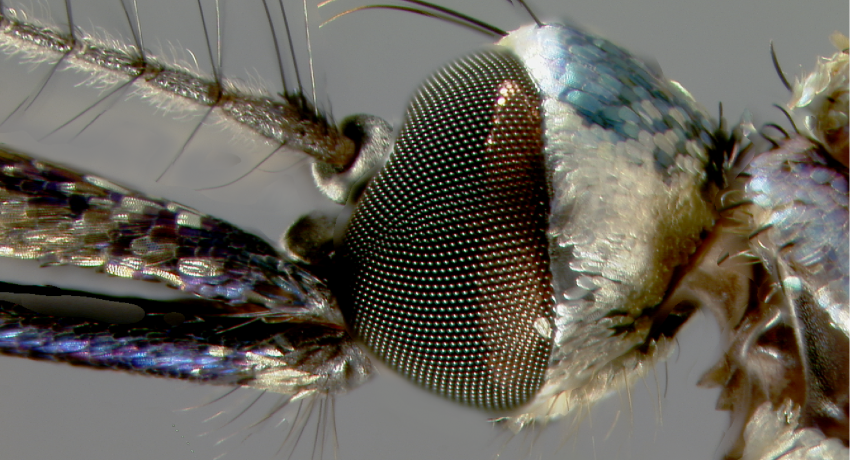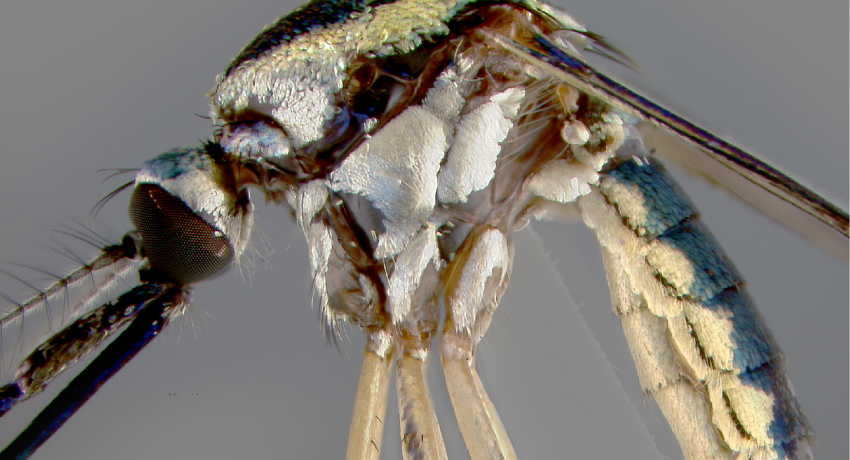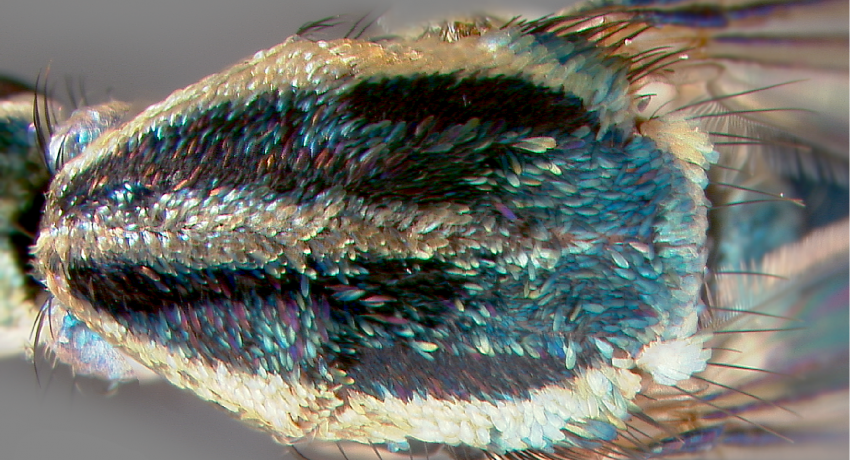AFROTROPICAL, AUSTRALASIAN, ORIENTAL, NEARCTIC, NEOTROPICAL & PALEARCTIC REGIONS
Generic abbreviation: Tx.
Type species: Toxorhynchites brevipalpis Theobald (ICZN 1959b (Opinion 548; validates name Toxorhynchites)).
Etymology: not stated [toxo- curved (Gr), snout.; ref. to downward curved proboscis].
Forest-associated species of the genus Toxorhynchites are large (>18mm) and often highly ornate, with colorful, iridescent scales and flamboyant scale-tufts on the abdominal tail. Unique within the subfamily Culicinae, the scutellum of Toxorhynchites appears evenly rounded—a character most commonly associated with Anopheline mosquitoes (except Chagasia).
There are 90 recognized species in the genus Toxorhynchites, which are subdivided into four subgenera: Afrorhynchus (19 species, Afrotropics), Ankylorhynchus (four species, Neotropics), Lynchiella (15 species)—all in the Neotropics, with Tx. rutilus extending into the Nearctic), and Toxorhynchites (51 species, Old World).
DIAGNOSTIC CHARACTERS (Click photos to view; mouse over and click large photo to zoom in.)
ADULT (illustrated): Very large mosquito, often covered with intensely colored iridescent scales. Head: Proboscis long, tapered and bent distinctively downward, originates from a deep cavity on the head capsule. Thorax: Posterolateral abdominal scale tufts present. Wing: Alula and upper calypter bare; distinct sclerotization in cell M4 in front of vein Cu; wing margin distinctly emarginate near the terminus of vein CuA; scutellum evenly rounded, not lobed; no setae on acrostichal, dorsocentral and prescutellar areas.
LARVA (not illustrated): Head: Clypeus short; mouthparts modified for predation; lateral palatal brush of ≤10 flattened filaments.
TAXONOMIC KEYS
Barraud 1934 (as Megarhinus; central Asia)
Edwards 1941 (as Megarhinus; Afrotropics)
van Someren 1946b: 177 (Ethiopian Region)
Hopkins 1952 (Afrotropics)
Vargas 1953b: 27 (North & Central America)
Lane 1953 (Neotropical Region)
da Costa Lima et al. 1962: 225 (Ankylorhynchus & Lynchiella)
Tanaka et al. 1979 (Japan)
Clark-Gil & Darsie 1983 (Guatemala)
Darsie 1985 (Argentina)
Rattanarithikul & Harrison et al. 2005 (Thailand)
Tyagi et al. 2015 (SE Asia)
![]()
WRBU – Genera – Global – Larva
![]()
WRBU – Genera – Afrotropical – Adult
![]()
WRBU – Genera – Afrotropical – Larva
![]()
WRBU – Genera – Australasia – Adult
![]()
WRBU – Genera – Australasia – Larva
![]()
WRBU – Genera – IndoMalaya – Adult
![]()
WRBU – Genera – IndoMalaya – Larva
![]()
WRBU – Genera – Oriental – Adult
![]()
WRBU – Genera – Oriental – Larva
![]()
WRBU – Genera – Eastern Palearctic – Adult
![]()
WRBU – Genera – Eastern Palearctic – Larva
![]()
WRBU – Genera – Western Palearctic – Adult
![]()
WRBU – Genera – Western Palearctic – Larva
![]()
WRBU – Genera – Nearctic – Adult
![]()
WRBU – Genera – Nearctic – Larva
![]()
WRBU – Genera – Neotropical – Adult
![]()
WRBU – Genera – Neotropical – Larva
Exemplar DNA sequences
Tx. (Lynchiella) guadaloupensis COI: MF172385–88),
Tx. (Lyn.) haemorrhoidalis haemorrhoidalis COI: MF172389–93
Tx. (Lyn.) haemorrhoidalis superbus COI: MF172394–403
Tx. (Lyn.) moctezuma COI: MF172404
Tx. (Lyn.) theobaldi COI: KY782648–55
Tx. (Toxorhynchites) splendens COI: KY411577–89
Tx. (Tox.) towadensis COI: LC054522–26
All Toxorhynchites DNA sequences
BIONOMICS
Immatures
The carnivorous larvae of Toxorhynchites are found in plant containers in forest environs, including pitcher plants, tree holes, and bamboo stumps. Larvae are stout, with heavily chitinized mouthparts for grasping and consuming their aquatic prey. Their highly predatory behavior and insatiable appetite has been exploited for biocontrol in high-density larval sites of malaria vector mosquitoes, such as rice fields, and in the container breeder habitats of Aedes aegypti and Ae. albopictus.
Adults
Toxorhynchites females are autogenous—that is they do not require a blood meal to produce their eggs, due to high protein reserves accrued as larvae. Thus both males and females are instead sustained on carbohydrate-rich honeydew, nectar, fruits and decaying organic refuse. Toxorhynchites adults are active during the day.
*Associated pathogens: This list reports bacteria, viruses, and parasites recovered from, or experimentally passed through this species, and does not imply field vector status.
IMPORTANT REFERENCES (full citations below)
Theobald 1901b:234 (July 15) (as genus, subgenus)
Theobald 1901a:244 (Nov. 23) (as genus, subgenus)
Barraud 1934 (as Megarhinus; central Asia)
Edwards 1941 (F, P; keys; as Megarhinus; Afrotropics)
van Someren 1946b: 177 (key; Ethiopian Region)
Stone 1948 (tax.; Megarhinus replaced by Toxorhynchites)
Hopkins 1952 (L; key; Afrotropics)
Vargas 1953b: 27 (key; North & Central America)
Lane 1953 (tax. keys; Neotropical Region)
Stone & Knight 1957d (ICZN, Toxorhynchites)
Thurman 1959b (Thailand)
da Costa Lima et al. 1962: 225 (revision; key; Ankylorhynchus & Lynchiella)
Belkin 1962 (review; South Pacific)
Forattini 1965 (Neotropical Region)
Cova-García et al. 1966 (Venezuela)
Belkin 1968b: 32 (type information)
Mattingly 1969b: 13 (E*)
Belkin et al. 1970 (New World)
Berlin & Pandian 1973a: 274 (Catalog; India)
Harbach 1977 (phylogeny)
Harbach 1978 (phylogeny)
Tanaka et al. 1979 (F, L; keys, taxonomy, bionomics; Japan)
Steffan et al. 1980 (annotated bibliography)
Steffan 1981 (type information; NMNH)
Steffan & Evenhuis 1981 (bionomics)
Clark-Gil & Darsie 1983 (keys; Guatemala)
Darsie 1985 (keys; Argentina)
Mitchell & Darsie 1985 (review, bibliography, distribution; Argentina)
Steffan & Evenhuis 1985 (phylogeny; subgenus Toxorhynchites)
Evenhuis & Steffan 1986 (Acaudatus Group; Oriental Region)
Lee et al. 1988c (subg. Toxorhynchites; Australasia)
Service 1990 (Afrotropicals)
Ribeiro 1991 (tax.; Brevipalpis Group; Afrotropics)
Manning et al. 1982 (catalog supplement)
Ribeiro 1992b (subenus Afrorhynchus)
Harbach & Kitching 1998 (phylogeny)
Collins & Blackwell 2000 (bionomics)
Mitchell et al. 2002 (molecular phylogeny; as tribe in subfamily Culicinae)
Ribeiro, 2004 (taxonomy; subgenus Afrorhynchus; Madagascar)
Ribeiro 2005b (taxonomy, classification)
Rattanarithikul & Harrison et al. 2005 (F, L; taxonomy, keys, bionomics; Thailand)
Reidenbach et al. 2009 (molecular phylogeny; as member of subfamily Culicinae)
Tyagi et al. 2015 (taxonomy, keys, bionomics; SE Asia)
VALID SUBGENERA
Afrorhynchus Ribeiro [Afr.]
Ankylorhynchus Lutz [Ank.]
Lynchiella Lahille [Lyn.]
Toxorhynchites Theobald [Tox.]
CURRENT GENERIC & SUBGENERIC SYNONYMS
Toxorhynchites
syn. Worcesteria Banks 1906a: 779 (as genus). Type species: Worcesteria grata Banks.
syn. Teromyia Leicester 1908: 49 (as genus). Type species: Teromyia acaudata Leicester (Brunetti 1914: 72).
Lynchiella
syn. Megarhinus Robineau-Desvoidy 1827: 412 (not Rafinesque 1820). Type species: Culex haemorrhoidalis Fabricius.
syn. Megarhina Macquart 1838b: 32 (as genus). Harbach 2018c: 150 ”unjustified emendation of Megarhinus Robineau-Desvoidy 1827; preoccupied by Megarhina Le Peletier & Audinet-Serville 1828; senior [but invalid] synonym of Lynchiella Lahille 1904; synonymy by Evenhuis et al. 2016.”
syn. Megarrhina Skuse 1889: 1720 (variant spelling of Megarhinus Robineau-Desvoidy).
syn. Megarrhinus Stackelberg 1926: 50 (incorrect spelling of Megarhinus Robineau-Desvoidy).
CITED REFERENCES
Banks, C. S. (1906a). A new genus and species of Culicidae. Philippine Journal of Science, 1(7), 779–784.
Barraud, P. J. (1934). The fauna of British India, including Ceylon and Burma. Diptera. Vol. 5. Family Culicidae, tribes Megarhinini and Culicini (Vol. 5). London: Taylor and Francis.
Belkin, J.N. (1962). The mosquitoes of the South Pacific (Diptera, Culicidae) (Vols. 1 &2). Berkeley, California: University of California Press.
Belkin, J.N. (1968b). Mosquito studies (Diptera, Culicidae). IX. The type specimens of New World mosquitoes in European museums. Contributions of the American Entomological Institute, 3(4), 1–69.
Belkin, J.N., Heinemann, S.J., & Page, W.A. (1970). The Culicidae of Jamaica (Mosquito studies. XXI) Contributions of the American Entomological Institute, 6(1), 458.
Berlin, O.G.W., & Pandian, R.S. (1973a). Annotated list of nominal species of culicines of India I. Introduction. Genus Toxorhynchites. Mosquito Systematics, 5(4), 274–276.
Clark-Gil, S., & Darsie, Jnr., R.F. (1983). The mosquitoes of Guatemala: their identification, distribution and bionomics, with keys to adult females and larvae, in English and Spanish. Mosquito Systematics, 15(3), 151–284.
Collins, L.E., & Blackwell, A. (2000). The biology of Toxorhynchites mosquitoes and their potential for as biocontrol agents. Biocontrol News and Information, 21(4), 105N-116N.
Cova García, P., Sutil Oramas, E., & Rausseo, J.A. (1966). Mosquitos (Culicinos) de Venezuela. Vol. I (adults, Vol. II (larvae). Ministerio de Sanidad y Asistencia Social, Caracas, 410pp.
Cova García, P., Sutil, E., & Rausseo, J.A. (1966). Mosquitos (Culicinos) de Venezuela (Vol. II). Caracas: Ministerio de Sanidad y Asistencia Social, Caracas.
da Costa Lima, A., Guitton, N., & Ferreira, O. (1962). Comentários relativos ás espécies da tribo Toxorhynchitini (Megarhinini) com a descrição de uma espécie nova de Lynchiella (Diptera, Culicidae). Memórias do Instituto Oswaldo Cruz, 60(2), 225–252.
Darsie, R.F., Jr. (1985). Mosquitoes of Argentina. Part I. Keys for identification of adult females and fourth stage larvae in English and Spanish (Diptera, Culicidae). Mosquito Systematics, 17(3), 153-23–253.
Edwards, F.W. (1941). Mosquitoes of the Ethiopian Region. III. Culicine adults and pupae. Bulletin of the British Museum (Natural History) Entomology.
Evenhuis, N.L., & Steffan, W.A. (1986). Classification of the subgenus Toxorhynchites (Diptera: Culicidae) II. Revision of the Toxorhynchites acaudatus group. Journal of Medical Entomology, 23(5), 538–574.
Evenhuis, N.L., Pape, T., & Pont, A.C. (2016). Nomenclatural studies toward a world list of Diptera genus-group names. Part V: Pierre-Justin-Marie Macquart. Zootaxa, 4172(1), 1–211.
Forattini, O.P. (1965). Entomología Médica. 3.0 Volume. Culicini: Haemagogus, Mansonia, Culiseta, Sabethini, Toxorhynchitini. Arboviruses. Filariose bancroftiana. São Paulo: Universidade de São Paulo.
Harbach, R.E. (1977). Comparative and functional morphology of the mandibles of some fourth stage mosquito larvae (Diptera: Culicidae). Zoomorphologie, 87, 217–236.
Harbach, R.E. (1978). Comparative structure of the labiohypopharynx of fourth stage mosquito larvae (Diptera: Culicidae), with comments on larval morphology, evolution and feeding habits. Mosquito Systematics, 10(3), 301–333.
Harbach, R.E. (2018c). Culicipedia: species-group, genus-group and family-group names in Culicidae (Diptera). Wallingford, Oxfordshire, UK: CABI.
Harbach, R.E. & Kitching, I.J. (1998). Phylogeny and classification of the Culicidae (Diptera). Systematic Entomology, 23(4), 327–370.
Hopkins, G.H.E. (1952). Mosquitoes of the Ethiopian region. I. Larval bionomics of mosquitoes and taxonomy of culicine larvae (2nd ed.). London, UK: British Museum (Natural History).
Lahille, F. (1904). Notes sur la classification des moustiques. Actas y Trabajos de Segundo Congreso Medico Latino-Americano (Buenos Aires), 2, 71–96.
Lane, J. (1953). Neotropical Culicidae (Vols. I, II). São Paulo: University of São Paulo.
Le Peletier, A.I. & Audinet-Serville, J.G. (1828). pp 345–832, [1]. In: Latreille, P. A. (ed.), Histoire naturelle. Entomologie, ou histoire naturelle des crustacés, de arachnids et des insects.
Lee, D.J., Hicks, M.M., Debenham, M.L., Griffiths, M., Bryan, J.H., & Marks, E.N. (1988c). The Culicidae of the Australasian region. Volume 10. Commonwealth Department of Health, School of Public Health and Tropical Medicine Monograph Series, 2.
Leicester, G.F. (1908). The Culicidae of Malaya. Studies from the Institute for Medical Research, Federated Malay States, 3(3), 18–261.
Macquart, J. (1838b). Diptères exotiques nouveaux ou peu connus. Tome premier. - 1 re Partie. Libraire Encyclopedique de Roret, Paris. 323 pp.
Manning, D.L., Evenhuis, N.L., & Steffan, W.A. (1982). Supplement to annotated bibliography of Toxorhynchites (Diptera: Culicidae). Journal of Medical Entomology, 19, 429–186.
Mattingly, P.F. (1969b). Mosquito eggs. I. Mosquito Systematics Newsletter, 1(2), 13–16.
Mitchell, A., Sperling, F.A.H., & Hickey, D.A. (2002). Higher-level phylogeny of mosquitoes (Diptera: Culicidae): mtDNA data support a derived placement for Toxorhynchites. Insect Systematics and Evolution, 33(2), 163–174.
Mitchell, C.J., & Darsie, R.F., Jr. (1985). Mosquitoes of Argentina Part II. Geographic distribution and bibliography (Diptera, Culicidae). Mosquito Systematics, 17, 279–360.
Rattanarithikul, R., Harrison, B.A., Panthusiri, P., & Coleman, R.E. (2005). Illustrated keys to the mosquitoes of Thailand. I. Background; geographic distribution; lists of genera, subgenera, and species; and a key to the genera. Southeast Asian Journal of Tropical Medicine and Public Health, 36(1), 1–80.
Reidenbach, K.R., Cook, S., Bertone, M.A., Harbach, R.E., Wiegmann, B.M., & Besansky, N.J. (2009). Phylogenetic analysis and temporal diversification of mosquitoes (Diptera: Culicidae) based on nuclear genes and morphology. BMC Evolutionary Biology, 9(1), Article 298.
Ribeiro, H. (1991). Research on the mosquito subfamily Toxorhynchitinae (Diptera: Culicidae). I. The Afrotropical group brevipalpis (adults) (1). Arquivos do Museu Bocage [Universidade de Lisboa; Museu e Laboratório Zoológico e Antropológico], 2(3), 31–62.
Ribeiro, H. (1992b). Research on the mosquito subfamily Toxorhynchitinae (Diptera: Culicidae) II. - Description of the Afrotropical subgenus Afrorhynchus subgen. nov. Mosquito Systematics, 23(3)(1991), 195–198.
Ribeiro, H. (2004). The Toxorhynchites Theobald of Madagascar (Diptera: Culicidae). Annales de la Société Entomologique de France, 40(3–4), 243–257.
Ribeiro, H. (2005b). Systematics and identification of Afrotropical Toxorhynchitinae (Diptera: Culicidae). Journal of Medical Entomology, 42(6), 953–958.
Robineau-Desvoidy, A.J.B. (1827). Essai sur la tribu des culicides. Société d’histoire naturelle, 3, 390–413.
Service, M.W. (1990). Handbook to the Afrotropical toxorhynchitine and culicine mosquitoes, excepting Aedes and Culex. British Museum (Natural History).
Skuse, F.A.A. (1889). Diptera of Australia. Part V.- The Culicidae. Proceedings of the Linnean Society of New South Wales, 3, 1717–1764.
Stackelberg, A. (1926). Megarhinus christophi Portsch. A translation from Stachelberg. Tableaux Analytiques de la Faune de l'URSS (Musee Zoologique de l'Academie des Sciences). 1pp.
Steffan, W.A, Evenhuis, N.L., & Manning, D.L. (1980). Annotated bibliography of Toxorhynchites (Diptera: Culicidae). Journal of Medical Entomology, 17 (Suppl. 3), 1–140.
Steffan, W.A. (1981). The type-specimens of Toxorhynchites (Diptera: Culcidae) at the National Museum of Natural History. Mosquito Systematics, 12 (4, 1980), 379–385.
Steffan, W.A., & Evenhuis, N.L. (1981). Biology of Toxorhynchites. Annual Review of Entomology, 26, 159–181.
Steffan, W.A., & Evenhuis, N.L. (1985). Classification of the subgenus Toxorhynchites (Diptera: Culicidae). 1. Australasian, eastern Palaearctic, and Oriental species groups. Journal of Medical Entomology, 22(4), 421–446.
Stone, A. (1948). A change of name in mosquitoes. Proceedings of the Entomological Society of Washington, 50(6), 161.
Stone, A., & Knight, K.L. (1957d). Proposed use of the plenary powers to validate the generic name Toxorhynchites Theobald as published in 1901 in the J. Tropical Medicine (Class Insecta, Order Diptera). Bulletin of Zoological Nomenclature, 13, 128–131.
Tanaka, K., Mizusawa, K., & Saugstad, E.S. (1979). A revision of the adult and larval mosquitoes of Japan (including the Ryukyu Archipelago and Ogasawara Islands) and Korea (Diptera: Culicidae). Contributions of the American Entomological Institute, 16, 1–987.
Theobald, F.V. (1901a). A monograph of the Culicidae or mosquitoes (Vol. 1). London: British Museum (Natural History). [424pp]
Theobald, F.V. (1901b). The classification of mosquitoes. Journal of Tropical Medicine, 4, 229–235.
Thurman, E.B. (1959b). A contribution to a revision of the Culicidae of northern Thailand. Bulletin of the University of Maryland Agriculture Experimental Station A, 100, 1–177.
Tyagi, B.K., Munirathinam, A., Krishnamoorthy, R., Baskaran, G., Govindarajan, R., Krishnamoorthi, R., . . . Venkatesh, A. (2015). A revision of genus Toxorhynchites Theobald, 1901, in the South-East Asian countries, with description of a new species Toxorhynchites (Toxorhynchites) darjeelingensis from West Bengal, India (Diptera, Culicidae). Halteres, 6, 13–32.
van Someren, E.C.C. (1946b). Ethiopian Culicidae. Tribe Megarhinini - notes and descriptions. Transactions of the Royal Entomological Society of London, 97, 177–186.
Vargas, L. (1953b). Megarhinus de Norteamerica (Diptera: Culicidae). Revista del Instituto de Salubridad y Enfermedades Tropicales (Mexico), 13, 27–32.
CITE THIS PAGE
Walter Reed Biosystematics Unit (Year). Toxorhynchites genus page. Walter Reed Biosystematics Unit Website, http://wrbu.si.edu/vectorspecies/genera/toxorhynchites, accessed on [date (e.g. 03 February 2020) when you last viewed the site].







